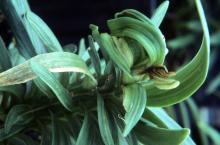Cause Aphelenchoides fragariae has a wide host range (including Anemone, begonia, and phlox) and is a pest of various kinds of lily in northern and southwestern Oregon. Nematode infections are transferred to other areas and from one season to the next in planting stock. Plant-to-plant spread in field and greenhouse plantings occurs especially when plants are close together. Spread can be rapid even when low-volume irrigation spray stakes are used in the greenhouse. Foliar nematodes generally are in the plant's buds and leaves but may be in soil as well. They can survive in the soil alone for 3 months or longer in plant tissue. The life cycle can be completed in 10 to 13 days and they are rapid swimmers.
Symptoms Bunchy-top and dieback conditions are symptoms of foliar nematodes. Infected leaves are blotchy, then turn yellow or brown and wither back against the stem. Terminal leaves are distorted, thickened, and point up in various directions. Another common symptom is "blossom blasting." Easter lilies so affected in the field and greenhouse cultures are referred to as "blind." Nematodes thrive in young flower buds, often injuring them so that blooming is retarded or the flowers destroyed. Infected plants show more than one symptom at a time.
Bunchy-top, dieback, and blossom blasting are common symptoms of many infected Easter and other garden lilies. A notable exception is the Rubrum lily. Infected leaves show purplish areas before turning brown and wilting back to the stem. Symptoms usually appear in late summer in all garden lilies except Easter lilies, in which they appear in late spring. Infection from this nematode moves along the row, seldom causing a target-spot pattern.
Sampling If a plant is suspected of having these nematodes, only the affected plant parts need to be submitted for diagnosis.
Cultural control
- Roguing lily planting for foliar nematodes is common practice. It is difficult to detect infection at an early stage, so roguing must be repeated several times during the season.
- Infected bulblets are treated successfully in a hot water bath of 111°F (43.5°C) for 1 hour. Treatment is best on bulblets only, reducing the volume of treated material and avoiding plant injury, which often follows treatment of larger bulbs. After treatment, soak bulbs in fungicide to protect against rot.
- Avoid overhead irrigation or any practice that keeps plants wet for extended periods of time or splashes water from one plant onto another.
- Remove and destroy all plant debris at season's end.
Chemical control These nematodes are also sensitive to organophosphate insecticides. Check the PNW Insect Management Handbook for current registrations and/or warnings on phytotoxicities.
- Cinnerate at 16 to 50 fl oz/100 gal water plus an adjuvant. No reentry listed. O
- Pylon miticide at 5.2 to 10 fl oz/100 gal water is labeled for oriental lily. For greenhouse use only. 12-hr reentry.
Reference Chastagner, G.A., van Tuyl, J.M., Verbeek, M., Miller, W.B., and Westerdahl, B.B. 2018. Diseases of Lily. In McGovern, R.J. and Elmer, W.H. (eds.) Handbook of Florists' Crops Diseases. Springer Int.


